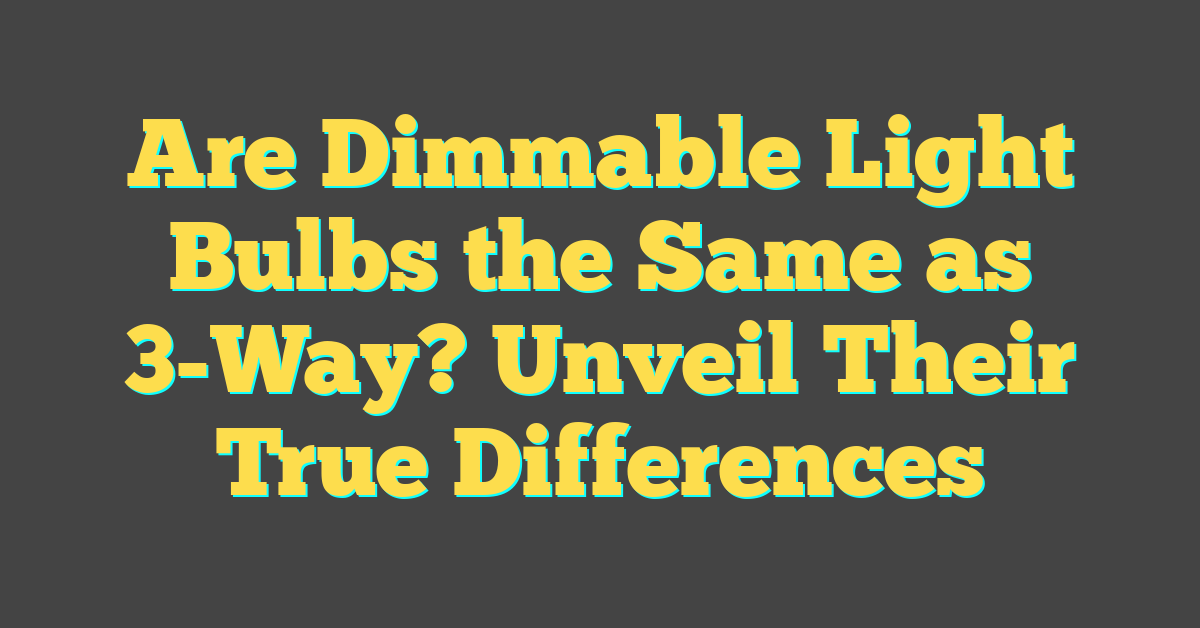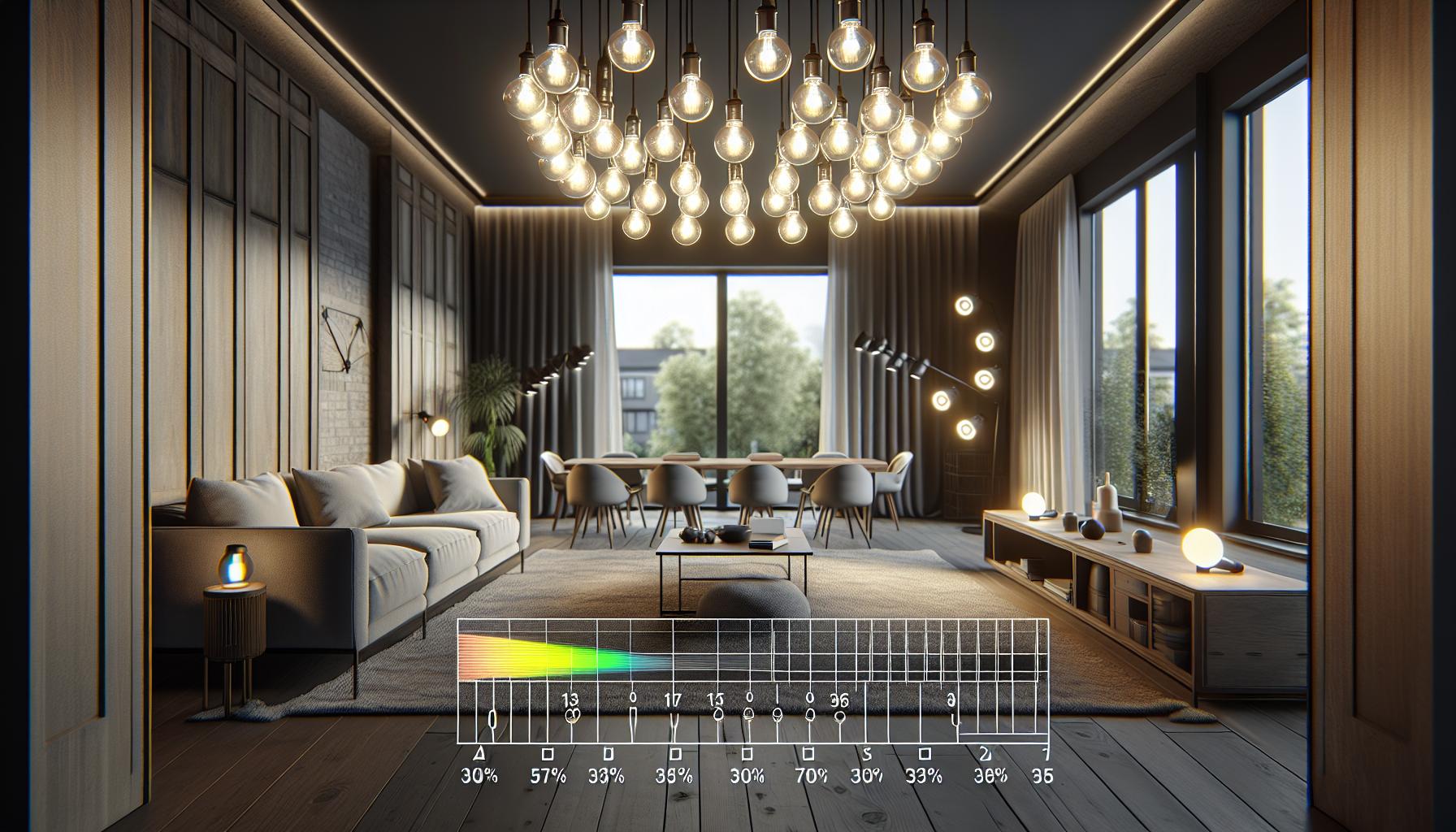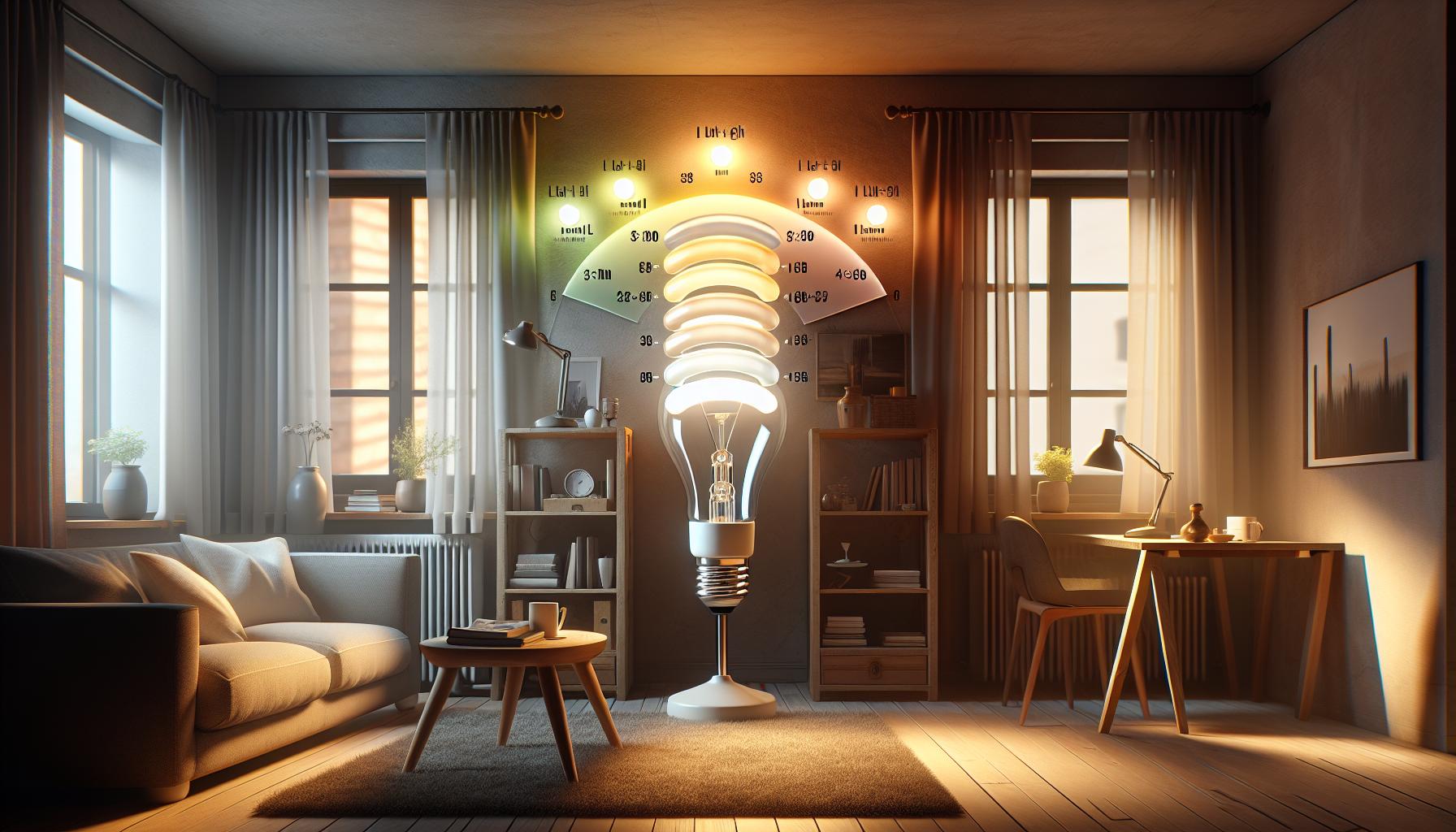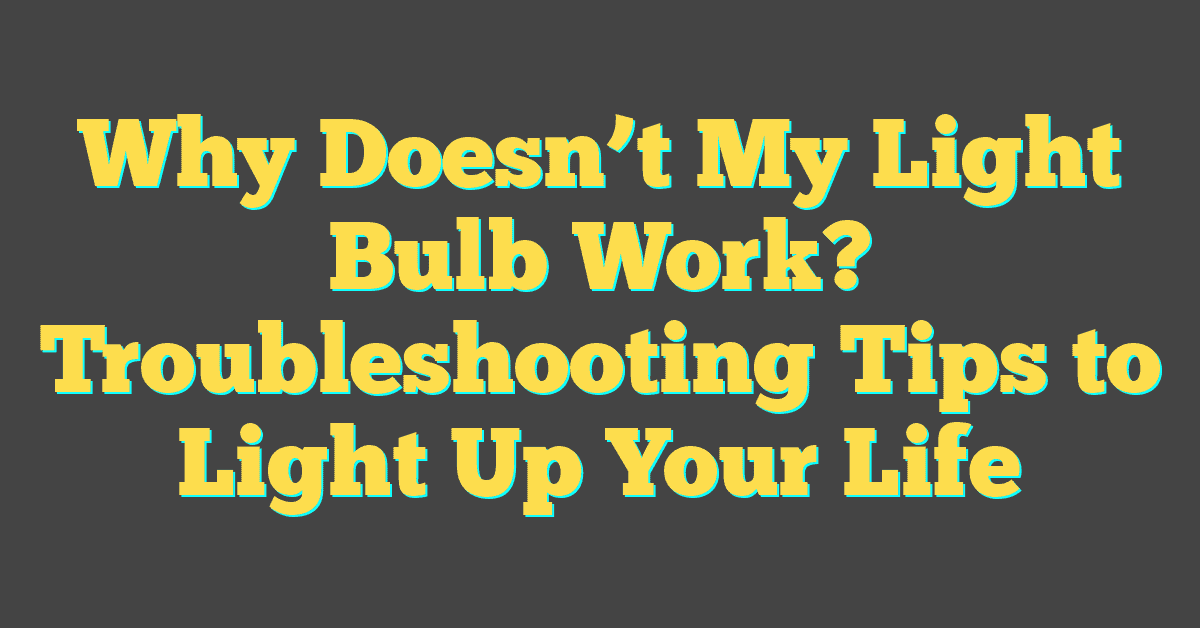Ever found yourself standing in the lighting aisle, scratching your head at the plethora of bulb options? You’re not alone. One common quandary is whether dimmable light bulbs and 3-way bulbs are birds of a feather. It’s easy to mix them up, but they’re more like distant cousins in the lighting family.

Dimmable bulbs let you tweak the brightness with a dimmer switch, setting the perfect mood for any occasion. On the flip side, 3-way bulbs flip the script with three distinct brightness levels, all without a dimmer. They’re like a choose-your-own-adventure book for lighting.
Understanding the difference can save you from a dimly lit disappointment or an overly bright blunder. So let’s shed some light on the subject and find out if it’s time to dim the lights or switch gears to a 3-way bulb.
Dimmable Light Bulbs vs. 3-Way Bulbs: What’s the Difference?
When you’re knee-deep in your latest home DIY project, the last thing you want is lighting that doesn’t fit the bill. That’s why knowing the nitty-gritty of dimmable and 3-way bulbs is essential. Both offer control over your lighting, but they operate quite differently.
Dimmable bulbs work with a dimmer switch, smoothly transitioning from bright to subdued to craft the perfect ambiance. They’re ideal when you crave variability in a single space. However, they require a specific type of switch and are sensitive to the type of dimmer you pair them with – not all dimmers are compatible with all dimmable bulbs.
In contrast, 3-way bulbs have a built-in mechanism that cycles through three levels of brightness: low, medium, and high. These bulbs don’t need special switches; they work with a standard 3-way socket, making them a go-to for bedside lamps or reading nooks where fixed levels of light are convenient.
While both offer a range of brightness, they’re not interchangeable. Using a dimmable bulb in a 3-way fixture doesn’t unlock the three distinct settings, and vice versa, a 3-way bulb in a standard lamp will not offer the versatility of a dimmer.
When choosing between the two, consider the following:
- Location: Where will the bulb be used? Does the space require flexible lighting or just a few set levels?
- Fixture Type: Does your fixture support 3-way functionality or is it compatible with a dimmer?
- Personal Preference: Are you looking for a simple solution or do you prefer the fluid control offered by dimmable bulbs?
Armed with this knowledge, you’re ready to light up your living space in a way that best suits your needs without the headache of mismatched technology. Remember, the right light not only illuminates a room but also enhances the mood and functionality of your space. So pick wisely, and let your light shine just the way you want it.
The Benefits of Dimmable Light Bulbs

As you dive deeper into the realm of home lighting, you’ll discover that dimmable light bulbs are not just about controlling brightness; they’re a way to customize your living space to your moods and needs. With the ability to adjust lighting levels, these versatile bulbs can drastically improve your home’s ambiance and even save energy when used properly.
Enhanced Ambiance and Mood
Creating the perfect atmosphere is an art, and with dimmable bulbs, you’re the artist. These bulbs enable you to:
- Set the room’s mood from lively and vibrant to calm and cozy.
- Lower brightness for a romantic dinner or a tranquil bath.
- Increase light levels when you’re reading or working on DIY projects where details matter.
Energy Savings and Longevity
Dimming your lights isn’t just about ambiance—it’s also smart for your wallet and the environment. When you dim a bulb, you reduce its power consumption, leading to:
- Significant energy savings, since less electricity is used at lower brightness levels.
- Extended bulb life, which means fewer replacements and less waste.
Flexibility in Functionality
Dimmable bulbs provide flexibility that 3-way bulbs can’t match. They offer:
- A continuous range of brightness levels, giving you absolute control over lighting intensity.
- Compatibility with smart home systems, enabling you to adjust lighting remotely or through voice commands.
- The possibility to pair with motion sensors and timers, further enhancing energy efficiency and convenience.
Health and Well-being
As a light bulb enthusiast, you’re well aware of the impact lighting can have on your well-being. Dimmable light bulbs:
- Help in regulating circadian rhythms by mimicking natural daylight changes.
- Can reduce eye strain by providing appropriate lighting for different times of the day and various activities.
« How to Keep Light Bulbs from Sticking: Unlock Easy Removal Tips
What Light Bulbs Can You Not Touch? Handle With Care to Prolong Life »
By understanding the distinctions between dimmable and 3-way bulbs, as previously discussed, you’re now aware of the bespoke benefits that dimmable lighting can offer. Whether you’re a home DIY aficionado or simply looking for ways to improve your living space, reviewing these benefits is essential before making your choice. Dimmable bulbs not only grant you control over your environment but also contribute to a more energy-efficient and welcoming home.
How Do 3-Way Bulbs Work?

Picture this: you’re ready to dive into your latest page-turner, but your standard lamp is either too dim or blazingly bright. That’s where 3-way bulbs step in to save the day. Unlike the smooth dimming curve of dimmable bulbs, 3-way bulbs have a unique design that allows for three distinct levels of light: low, medium, and high. This nifty feature is tailor-made for your evening wind-downs or your focus-intensive tasks.
At the heart of a 3-way bulb, there are two filaments of different wattages. Only one of these filaments lights up when you turn the switch to the first setting, giving you a cozy, subdued glow. Flip the switch again, and you’ll illuminate the second filament, resulting in a brighter light. When both filaments are on, you get the highest level of brightness, perfect for those DIY projects where you need every detail sharp and visible.
To work their magic, 3-way bulbs need a companion: a 3-way socket. This special socket contains contacts wired to deliver electricity to one or both filaments, depending on the position of the lamp’s switch. It’s a clever dance between the bulb and the socket, producing versatile lighting without the need for a dimmer. If you’re rocking a standard socket, though, keep in mind, a 3-way bulb will only operate at one level of brightness—usually the highest.
The table below illustrates how the 3-way bulb works at different settings:
| Setting | Illuminated Filament | Light Intensity |
|---|---|---|
| Low | First | Cozy Glow |
| Medium | Second | Brighter Light |
| High | Both | Maximum Brightness |
So, while dimmable bulbs offer you a continuous range, 3-way bulbs provide specific levels of brightness, each suited for different activities and times of day. It’s easy to see why they’re favored in fixtures all around the home, from bedside lamps to workspace lighting. Choosing the right type of lighting is vital for your comfort and to ensure your space is always lit just the way you like it.
Comparing Dimmable Bulbs and 3-Way Bulbs: Pros and Cons

When you’re knee-deep in your latest home DIY project or deciding on the right ambiance for your space, understanding the nuances between dimmable bulbs and 3-way bulbs can make or break your lighting setup. Let’s shed some light on the advantages and drawbacks of each to help you make an informed decision.
Dimmable Bulb Advantages
- Flexibility: With these bulbs, you can adjust the brightness to your exact liking, which is perfect for creating different moods or for functional tasks that require more or less light.
- Energy Efficiency: They often use less electricity, helping to reduce your utility bills over time.
- Longevity: Dialing down the intensity can also extend the life of the bulb.
Dimmable Bulb Drawbacks
- Compatibility: Not all dimmable bulbs work with all dimmer switches, which means you may need to invest in compatible hardware.
- Cost: Initial costs can be higher compared to traditional bulbs.
3-Way Bulb Advantages
- Convenience: The ability to switch between three preset levels of light (low, medium, high) provides a quick way to adjust brightness without needing a dimmer switch.
- Availability: These bulbs are readily available and work with special 3-way sockets, which are also common in many homes.
- Limited Settings: Unlike the continuous range of a dimmable bulb, you’re confined to only three light levels.
- Socket Requirement: A standard socket won’t work. You’ll need to ensure your lamp or fixture has a 3-way socket.
As someone who’s passionate about getting the details just right, you know the importance of light in pulling together the look and feel of a room. Remember, the choice between dimmable bulbs and 3-way bulbs will also depend on your specific needs and the atmosphere you intend to create. With this comparison, you’re well-equipped to illuminate your home, matching functionality with style.
Finding the Right Bulb for Your Needs

When it’s time to choose the lighting for your space, consider your environment and what you’ll be doing there. Is the room a cozy corner for reading and relaxing or a dynamic area for entertaining guests? These questions matter because they directly affect which bulb will complement your lifestyle.
Consider the Atmosphere You Want to Create
For those moments when you’re after a subdued ambiance, dimmable bulbs are your allies. They allow you to adjust brightness with precision, meaning you can go from full-on illumination to a subtle glow with just a twist of a knob or a press on a smart device. However, remember that your existing fixtures should support dimming, and you may need to invest in a compatible dimmer switch.
On the other hand, if you crave simplicity without the need for additional hardware, 3-way bulbs might be more up your alley. You’ll get a lamp that offers three levels of light, typically soft, medium, and bright, which is straightforward and user-friendly. Just ensure your lamp base is designed for a 3-way bulb.
Evaluate Usage and Energy Efficiency
Think about how often and for how long you’ll be using the lights. Since dimmable bulbs can reduce power consumption based on brightness levels, they can be perfect for rooms used frequently. Lower energy use not only saves on your electric bill but also means longer bulb life.
| Type | Dimmable Bulbs | 3-Way Bulbs |
|---|---|---|
| Energy Saving | High | Moderate |
| Bulb Lifespan | Longer | Standard |
| Flexibility | High | Moderate |
| Initial Cost | Higher | Lower to Medium |
Make an Informed Decision
Don’t jump to conclusions based solely on price or popularity. You should think about long-term benefits and compatibility with your current system. Sometimes a little extra up-front can save you more in the long run with fewer replacements and lower electricity usage. Understanding the unique features and constraints of both dimmable and 3-way bulbs helps you make a choice that aligns with your personal preferences and environmental needs.
Conclusion
You’ve seen that both dimmable and 3-way bulbs have their unique benefits tailored to your needs. It’s all about what works best for your space and how you want to control your ambiance. Remember, while dimmable bulbs offer versatility in brightness, they do need the right environment to shine. Meanwhile, 3-way bulbs are all about ease of use, as long as you have the right lamp. Think about the long haul—energy efficiency and lifespan are key. So go ahead, weigh your options, and light up your world in a way that’s just right for you.
Frequently Asked Questions
What are the main benefits of dimmable bulbs?
Dimmable bulbs offer adjustable brightness levels, which allows for greater flexibility in creating the desired ambience. They are also more energy-efficient than traditional bulbs and tend to have a longer lifespan.
Do dimmable bulbs require any special fixtures?
Yes, dimmable bulbs require compatible fixtures and potentially a compatible dimmer switch to work properly. It is essential to ensure that your lighting setup is suited for dimmable bulbs before installation.
What are the key advantages of 3-way bulbs?
3-way bulbs are known for their simplicity and ease of use, as they do not require special switches. They also provide different levels of brightness with just a turn of the switch and are designed to fit in lamps with a 3-way base.
Can I use a 3-way bulb in any lamp?
No, 3-way bulbs need specific lamp bases designed to accommodate their function. Using a 3-way bulb in a regular lamp base will not provide the intended variation in brightness.
How does the energy efficiency of dimmable bulbs compare to 3-way bulbs?
Dimmable bulbs are generally more energy-efficient because they can be dimmed to lower levels, consuming less electricity. Whereas 3-way bulbs offer fixed levels of energy use depending on the setting chosen.
Should I choose dimmable bulbs or 3-way bulbs?
Your choice should be based on the compatibility with your current fixtures, as well as your lighting needs and preference for convenience or ambiance. Consider the long-term benefits and environmental impact when making your decision.




